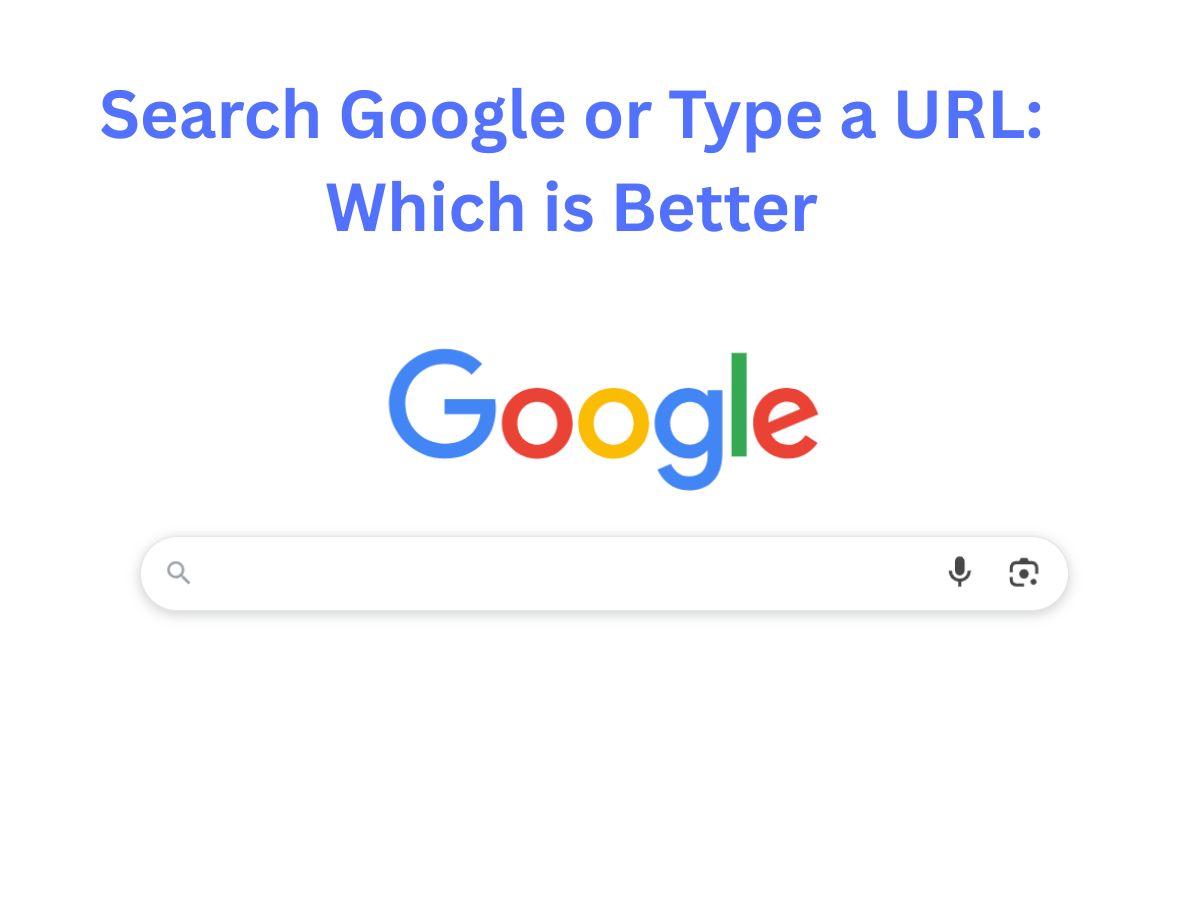Navigate the world’s massive knowledge base effortlessly- all by typing Google or creating your URL. Whether exploring new things, consciously buying something, or just wrapping yourself in a new thought, it all begins with a click in the search bar. Enter what you want to find, or just enter the URL to your preferred site and jump right in! Have a look at the day’s headlines, look at the popular stuff, take a look at the educational topics, or contact one that you haven’t seen for quite a while. The digital world is filled with possibilities – get exploring by searching or going straight to a site by its URL. With just one click, you can search Google or type a URL to find, discover, purchase, or connect wherever you need to go.
What is Search Google or Type a URL
When you launch any web browser (Google Chrome in this case), on the address bar, you’ll find the message to “Search Google or type a URL”. It is both the opening door to Google’s search abilities and the beginning of movement to any site with the entering of its URL. So, users can choose to search for information like “best restaurants near me” or “how to learn coding”, and have Google show the relevant results, or type in a URL for immediate access.
Its primary objective is to assist you in accessing information more quickly and conveniently. Instead of having to go to Google.com and begin searching there, you can initiate your search right from the main browser bar. Or, if you already have the exact URL of the site you wish to visit, you can just type this URL into the browser’s bar without having to search.
This functionality is fundamental in obtaining web services interaction today, making traversing simple and easy, which both new and advanced users find useful. Whether you want to search for information, make purchases, further your knowledge, or just explore for fun’s sake, this feature turns your web browser into a universal gateway to the internet.”
Search Google
Searching for information on the internet is made convenient and effective through the Google Search option. Whether you search for information about present events, items at discounts, study material, or any everyday question, Google links you to a vast number of web pages in a few seconds. Then all you need to do is put in what you are searching for, for example, ‘weather today’, ‘how to bake a cake’, or ‘best smartphones 2025’, and start your search. You will soon observe relevant results displayed through websites, pictures, films, maps, etc.
Google applies complex algorithms to analyse the relevance, authority, and recency of web pages to bring you the best information at the top of your results. Also, such modern tools as filters, voice command, or Google Lens will help you to filter your search results even further. Auto-suggestions, spell-check, and suggestions for linked searches create additional convenience in your experience.
You don’t have to go to Google.com to use the search feature (everything is built for compatibility, and you use search directly from the address bar of browsers such as Chrome and Safari). It allows you to use simple keystrokes to search, bypassing the need to open Google’s homepage. Get access to millions of resources immediately if you type in a few keystrokes. It offers quick, free, and continuous access, the gateway to most information available on the internet.
Type a URL
With the use of the “type a URL” function in your browser’s address bar, you can click through search results and directly on to a specific website by simply typing in its full web address. Instead of searching for what you want, you can just type in the website’s complete name. For example, assume you want to visit a news site, social network, or even a shopping site – typing in the entire URL will instantly redirect you to that site.
An easy/fast/click revise access to the specific page that you need. Using this technique, you don’t have to look for search results, and you can easily get to the page you need, saving your time and reducing the risk of clicking an inappropriate link. It proves handy any time you frequently access the same websites you have to work your way in, e.g., logging in or contacting support.
As you enter the corresponding URL, you can gain access to more trusted sites more securely – you bypass the threat of clicking on the deceptive or malicious search results. Using most browsers with auto-complete enabled, you can type a URL, and your choice of sites is likely to pop up before you finish typing the address.
In essence, choosing the “type a URL” feature will lead you directly at bare speed to your favorite websites, saving time and further improving your browsing experience.
Search Google or Type a URL: How to Search on Google
To get the best out of Google’s search facility, one should apply a meaningful search strategy rather than dumping in words. When the reliable and relevant outcomes are desired, the use of the smart search techniques matters. Start your search with exact keywords and not whole phrases. Do not frame your search as “What is the best way to learn English quickly?” and switch to a search like “best ways to learn English fast”.
To pull information for an exact word or phrase, use quotation marks; for instance, search for “climate change effects”. To skip over a word in the search results, add a minus sign behind the word; for example, the entry apple -fruit will bring up the Apple company and not the fruit. If you’re not sure about a word, try using an asterisk (wildcard).
Search narrowing can be done by selecting the domain of search, which includes searching for the official information by using “site: gov” or educational content by using “site:edu”. Toggle ON the filters such as “Images,” “News,” or “Videos,” and you’ll end up with the content you seek. Using Google’s “Tools allows you to change search entries according to when the content was published, found, etc.
Never look over the first results, review the snippets presented, and evaluate the credibility of the sources. With experience, your searches will take less time and precise, making your time and productivity increase. The power of Google boils down to knowing how to search effectively, and this ability is what speaks for you.
Search Google or Type a URL: How to Type a URL
Begin your URL entry with the appropriate protocol, such as “https” or “http”, include “://” between and your destination. While “http” can work, and so can “https”, it is advisable to use “ https” because it provides better additional security. Upon elaborating on the protocol, type the domain name – usually preceded by “www” and with the name of the site, and a domain suffix, such as “.com”, “.org”, or “.net”.
As the domain name is case-insensitive, always enter it in lower-case letters. But anything outside the domain itself – folders, file names, or parameters can be case sensitive, so type them exactly so that the computer knows what you mean. Avoid spaces in URLs. Where a space is necessary to appear, replace it with” % 20” or a plus sign, according to the context.
Make sure that you apply punctuation in your URLs correctly. In the domain, split out sections with periods, use slashes to define directories or paths, and always append a question mark at the start of query strings. A colon, hyphen, or underscore each denotes a specific meaning in URLs; avoid misusing or missing any of them.
Carefully review your spelling in your URL, and remove unnecessary symbols. Once a URL is typed in correctly, the users will be directed to the correct webpage smoothly. Make sure that the URL is error-free before you post the URL or visit the URL.
Key Difference Between Searching Google and Typing a URL
1. Purpose
If you don’t know precisely what address to search, search Google to find your search.
Type a URL is helpful if you can remember the website’s address exactly.
2. Input Type
In order to search Google, users need to type keywords, phrases, or question-like queries “best Italian restaurants”.
To type a URL requires an intricate web address to go to your destination (e.g., “example.com”).
3. Results
Through Google Search, you are provided with search results to wade through and select one to access.
By having a URL, you arrive at your target site without observing the search results.
4. Speed
Searching often means having to click several times as you click through search results in search of your target site.
If you know the URL in mind, going to a site goes faster as it skips the search feature and travels straight to your destination.
5. Accuracy Required
Google’s search feature also has corrections for mistakes in spelling, provides useful suggestions for similar searches.
A typographical error in the URL may cause a redirect to an unrelated site or a failure in the search.
Final Verdict: Search Google or Type a URL
After all, both searching on Google and entering a URL are the basic ways to access online information, each appropriate for certain needs. If you are not sure about the address of a website or just need to discover new aspects from a topic, searching is the preferred choice. If you remember the address of a certain website, simply typing the address in the address bar helps to move rapidly through the site. The correct choice between them can make your browsing faster and easier your online travels. Since these options can also be input into a browser’s address bar, people can choose the approach that is most appropriate for searching either broadly or exactly.










